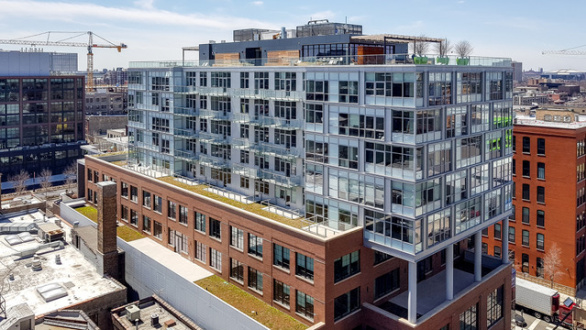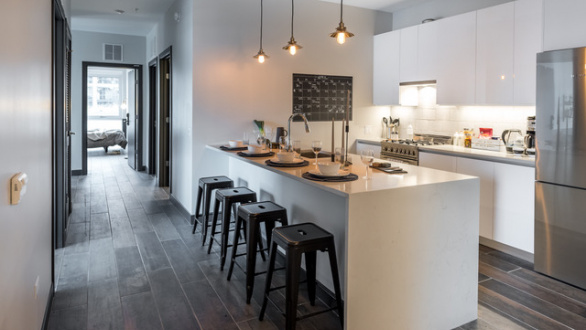Jonathan Restivo travels the world as a consultant in telecom development for Empire Blue Real Estate, and because of that, he no longer pays for a permanent home. He found an ad on Instagram for Roam, a co-living residential concept expanding in many parts of the globe. So far, he’s enjoyed stays in Roam’s London, Tokyo, San Francisco, and Bali properties. “I felt I needed to open myself up to meeting new, similarly-situated people, or else the whole experience would get pretty lonely,” says Restivo, 32.
People who choose co-living buildings pay rent for a private bedroom (sometimes with an en-suite bathroom) but share common spaces, such as kitchens, living rooms, or lounge-type spaces. These types of residences are mostly in big cities—where relocating renters may not know anyone—so the benefit of this living arrangement is an instant community and planned social activities for the building. Most co-living properties offer temporary leases. “With the right blend of people, the community aspect is really cool, and I’ve met some incredible people who are now friends,” Restivo says.
Co-living is getting noticed as one of the biggest trends in real estate throughout the world. It’s a new way of living in the 21st century, even though it’s a lifestyle that existed for generations. Now a surge of real estate developers and companies are seeing more opportunity in this growing movement.
Co-living in Action
In Chicago, one property making a splash is QUARTERS, located in the Fulton Market district of the busy West Loop neighborhood, right across from McDonald’s international headquarters and Google. The building offers 175 beds, which were already 80 percent occupied by the June 2018 grand opening. “It’s not Airbnb. It’s a place to live. It brings people together,” says Steve Caton, broker and co-owner of Caton Commercial Real Estate Group in Naperville, Ill., which operates QUARTERS.
Caton joined forces with Medici Living Group, the world’s largest co-living provider—which has had great success in Europe and New York—to open QUARTERS. “My father, Bill Caton, had been pushing for years to get into global business,” says Caton. “It’s growing worldwide, and it disrupts the residential marketplace by allowing shorter-term leases and being flexible. It’s a whole new class of residential real estate.”
The costs of co-living are typically 20 percent to 25 percent less per month than standard rentals, Caton explains. The bedroom is fully furnished and includes all utilities. Renters even receive sheets, towels, maid service, and free internet. Some companies entice new residents with chef-grade kitchens, swimming pools, pool tables, gyms, maker’s workshops, recording studios, and movie screening rooms.
But the flexibility that co-living properties offer is usually what wins over tenants. Once they are part of the co-living community, renters can change locations. For instance, QUARTERS requires a three-month commitment, then you can jet off to New York and other destinations where their facilities are located.
“Building a large footprint in Chicago and throughout the nation is a priority,” says QUARTERS CEO Gunder Schmidt. “In Chicago, we want to grow to 10,000 beds. Across the country, we are looking at key cities like Denver, San Francisco, L.A., Miami, and Detroit for expansion in the next 12 to 24 months.”
Meeting Market Demand
Many real estate companies are realizing that the self-employed, roaming entrepreneurs of today want to live a fulfilling life without paying astronomical prices. They want to be part of something bigger than themselves and feel a community presence.
Daisy Onubogu, Roam’s global head of community, advises real estate company leaders who are considering getting into the co-living industry to first figure out the target market in their area. “Co-living is filling a gap in the rental market because young people are becoming more mobile and want to live in the urban areas,” says Onubogu. But it’s a misconception that all co-living residents are single freelancers in their twenties. Roam assists artists, corporate professionals, consultants, retirees, bakers, lawyers, and even race car drivers.
Once you understand your target market, you need to build the experience that the market demands. Make sure you have a diverse and representative product team so that when they are making decisions on what your space and living experience will look like, they don’t end up missing the mark, Onubogu says.
Roam is committed to building a space so ideally calibrated that even the pickiest of people will enjoy it. This means thinking about how every aspect of the design impacts the user experience—from ensuring privacy in en-suite bathrooms to the building’s lightbulbs and the copywriting for the events newsletter. “It’s hard work, but seeing it pay off makes us so glad we chose to do it this way,” Onubogu says.
Is Your Market Ready for Co-Living?
Become the local expert and learn everything you can about co-living if you want to be competitive in this real estate niche, Caton says. “Co-living is so new in the United States that it gives any broker a chance to get in and be an expert. Developers and cities are looking for solutions,” he explains.
Don’t try to put the project together on your own. Visit co-living facilities already operating in the United States and afar, Caton recommends. “If you know the story behind it and talk with those living there, then you’ll know how to sell it,” he says. Co-living companies are popping up all over the world with names such as Common, Ollie, WeLive by WeWork, Nomad House, Unsettled, and Outside. You can find them now or coming soon to cities such as Washington, D.C.; Cincinnati; Austin, Texas; Miami; Portland, Ore.; Pittsburgh; Jersey City, N.J.; Boston; Brooklyn, N.Y.; Sacramento, Calif.; Nashville, Tenn.; and San Diego.
Every co-living development and company offers something different. Some properties are creating spaces just for female renters, while others are offering co-working spaces along with co-living areas. Most of the time, everything from toilet paper to weekly maid service are included in the price. But some places go way beyond, with amenities such as language schools, surf camps, yoga decks, hammocks, photography classes, and fitness centers.
The Gallery on Wells in Chicago just began the first chef-in-residence program to enhance its co-living offerings. The chef, Tyler Houston, is a sous chef at a restaurant next door, and he shares his expertise with residents in return for a free year of rent. In a survey, the residents had interest in grilling classes, outings to a farmers market, wine pairings, and seasoning lessons. Magellan Development Group and Mac Management began the artist-in-residence program at its Chicago and Nashville properties.
Finding the Right Location
Build and retain good relationships with developers who can help you find the right neighborhoods for co-living buildings. Caton strives to position QUARTERS in desirable neighborhoods with restaurants and other amenities nearby. Many co-living developers also are finding unique buildings for co-living purposes. For instance, Roam renovated the former arch bishop mansion for its San Francisco location.
Starcity, another player in the co-living market, identifies underutilized multifamily properties, hotels, and office or commercial buildings to develop into co-living homes, says company spokesperson Erin First. This strategy helps add to a city’s housing stock without displacing a community’s longtime residents. “On average, Starcity is able to deliver three times more housing than a typical apartment development,” First says.
Starcity is a full-stack real estate development, meaning the company identifies, acquires, develops, and manages their communities, First says. The company, which launched in 2016, locates its co-living communities near major transit hubs so that tenants can live in the city center and get around easily.
“Large urban centers are often very isolating environments,” Onubogu says. “People move only to discover an environment so vast and fast-paced that it can be difficult to find a tribe and that sense of belonging.”
By virtue of being a shared living space, a co-living property will help your brand build a tightknit community—even in the business of cities.







